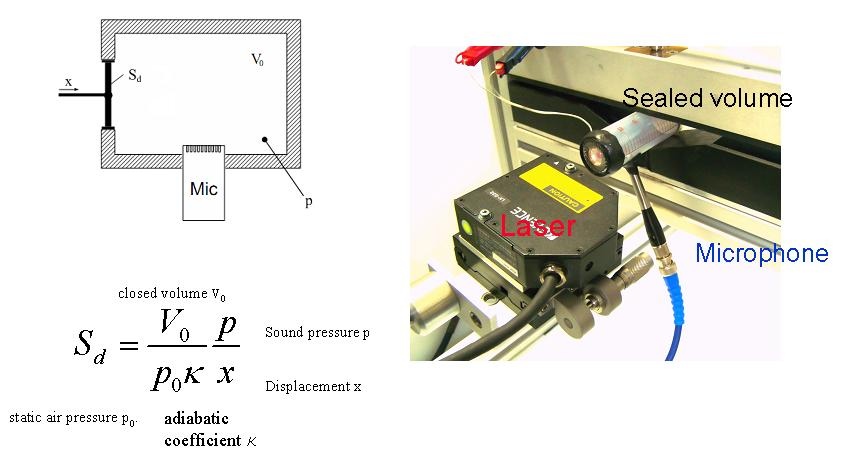Area of Radiation
Characteristics: | KLIPPEL R&D System |
|---|---|
| Effective radiation area Sd | TRF, SCN |
The effective radiation area Sd describes the surface of a piston moving with velocity of the voice coil and producing the same volume velocity as the radiator at low frequency where the all points of the surface are still in-phase. For woofers, where the width of the surround is small compared to the inner diameter of the cone, the effective radiation area may be approximated by the area using the average of the surround’s outer and inner diameter. This approximation fails in microspeakers and transducers for headphones and headsets where the surround area is relatively large and the curved geometry generates a nonlinear decay of the excursion versus the surround.
The effective radiation area Sd can be determined more accurately by operating the transducer in a small sealed enclosure (syringe) and by measuring the generated sound pressure inside the air volume and the displacement of the voice coil (see KLIPPEL Application Notes). The laser scanning technique which measures the vibration and geometry of the cone allows an automatic measurement of Sd at high precision. The effective radiation area Sd is one of the most important lumped parameters of the transducer which determines the efficiency and sensitivity of the transducer and which affects the accuracy of the mechanical parameters determined by performing a second perturbation measurement in a test enclosure.
The figure to the left shows automatic measurement of the effective radiation area Sd by using the laser scanning technique.
The figure to the left shows effective radiation area Sd from a measurement of sound pressure and voice coil displacement while operating the transducer in a sealed enclosure of volume Vo.
KLIPPEL R&D SYSTEM (development)
Module | Comment |
|---|---|
Transfer Function Measurement (TRF)
| Application Note AN 32 describes how to measure the effective radiation area Sd by operating the transducer in a sealed box and by measuring the sound pressure in the enclosed air and voice coil displacement. To seal the enclosure is critical and affects the precision. |
After scanning the vibration and geometry of the radiator, the effective radiation area Sd is calculated automatically. This technique is simple and gives the most accurate results. |
Example:
Application Notes
Standards
Audio Engineering Society
AES2 Recommended practice Specification of Loudspeaker Components Used in Professional Audio and Sound Reinforcement
International Electrotechnical Commission
IEC 60268-5 Sound System Equipment, Part 5: Loudspeakers
Other Related Tests
Typical Test Objects
Papers and Preprints
W.Klippel, J.Schlechter, "Dynamical Measurement of the Effective Radiation Area SD", presented at teh 128th Convention of the AES in London, UK, 2010, May 22-25.
O. Sandermann, et al., “Diaphragm Area and Mass Nonlinearities of Cone Loudspeakers,” presented at the 99th Convention of the Audio Eng. Soc., October 1995, Preprint 4082.
W. Klippel, et al., “Distributed Mechanical Parameters of Loudspeakers Part 2: Diagnostics,” J. of Audio Eng. Soc. 57, No. 9, pp. 696-708 (2009 Sept.).
W. Klippel, et al., “Distributed Mechanical Parameters of Loudspeakers Part 1: Measurement,” J. of Audio Eng. Soc. 57, No. 9, pp. 500-511 (2009 Sept.).
J. Moreno, et al., “Measurement of the Effective Radiating Surface Area of a Loudspeaker Using a Laser Velocity Transducer and a Microphone,” presented at the 96th Convention of the Audio Eng. Soc., February 1994, Paper No. 3861.

